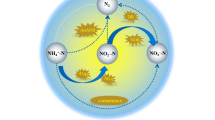Abstract
The influence of toluene concentration on the specific growth rate, cellular yield, specific CO2, and metabolite production by Pseudomonas putida F1 (PpF1) was investigated. Both cellular yield and specific CO2 production remained constant at 1.0 ± 0.1 g biomass dry weight (DW) g−1 toluene and 1.91 ± 0.31 g CO2 g−1 biomass, respectively, under the tested range of concentrations (2–250 mg toluene l−1). The specific growth rate increased up to 70 mg toluene l−1. Further increases in toluene concentration inhibited PpF1 growth, although inhibitory concentrations were far from the application range of biological treatment processes. The specific ATP content increased with toluene concentration up to toluene concentrations of 170 mg l−1. 3-Methyl catechol (3-MC) was never detected in the cultivation medium despite being an intermediary in the TOD pathway. This suggested that the transformation from toluene to 3-MC was the limiting step in the biodegradation process. On the other hand, benzyl alcohol (BA) was produced from toluene in a side chain reaction. This is, to the best of our knowledge, the first reported case of methyl monoxygenation of toluene by PpF1 not harboring the pWW0 TOL plasmid. In addition, the influence of 3-MC, BA, and o-cresol on toluene degradation was investigated respirometrically, showing that toluene-associated respiration was not significantly inhibited in the presence of 10–100 mg l−1 of the above-mentioned compounds.





Similar content being viewed by others

References
Alagappan G, Cowan R (2003) Substrate inhibition kinetics for toluene and benzene degrading pure cultures and a method for collection and analysis of respirometric data for strongly inhibited cultures. Biotechnol Bioeng 83(7):798–810
Alagappan G, Cowan R (2004) Effect of temperature and dissolved oxygen on the growth kinetics of Pseudomonas putida F1 growing on benzene and toluene. Chemosphere 54(8):1255–1265
An YJ (2004) Toxicity of benzene, toluene, ethylbenzene, and xylene (BTEX) mixtures to Sorghum bicolor and Cucumis sativus. Bull Environ Contam Toxicol 75(6):1006–1011
Assinder SJ, Williams PA (1990) The TOL plasmids: determinants of the catabolism of toluene and xylenes. Adv Microb Physiol 31:1–69
Christen P, Domenech F, Michelena G, Auria R, Revah S (2002) Biofiltration of volatile ethanol using sugar cane bagasse inoculated with Candida utilis. J Hazard Mater 89(2–3):253–265
Clesceri LS, Greenberg AE, Eaton AD (eds) (1998) Standard methods for the examination of water and wastewater, 20th edn. American Public Health Association/American Water Works Association/Water Environment Federation, Washington DC, USA
Croute F, Poinso J, Gaubin Y, Beau B, Simon V, Murat JC, Soleihavoup JP (2002) Volatile organic compounds cytotoxicity and expression of HSP72, HSP90 and GRP78 stress proteins in cultured human cells. Biochim Biophys Acta 1591:147–155
Duetz WA, de Jong C, Williams PA, van Andel JG (1994) Competition in chemostat culture between Pseudomonas strains that use different pathways for the degradation of toluene. Appl Environ Microbiol 60(8):2858–2863
Gibson DT, Hensley M, Yoshioka H, Mabry TJ (1970) Formation of (+)-cis-2,3-dihydroxy-1-methylcyclohexa-4,6-diene from toluene by Pseudomonas putida. Biochemistry 9:1626–1630
Halsey KH, Sayavedra-Soto LA, Bottomley PJ, Arp DJ (2005) Trichloroethylene degradation by butane-oxidizing bacteria causes a spectrum of toxic effects. Appl Microbiol Biotechnol 68(6):794–801
Heipieper HJ, Keweloh H, Rehm HJ (1991) Influence of phenols on growth and membrane permeability of free and immobilized Escherichia coli. Appl Environ Microbiol 57:1213–1217
Hüsken LE, Beeftink R, de Bont JAM, Wery J (2001) High-rate 3-methylcatechol production in Pseudomonas putida strains by means of a novel expression system. Appl Microbiol Biotechnol 55(5):571–577
Leddy MB, Philips DW, Ridgway HF (1995) Catabolite-mediated mutations in alternate toluene degradation pathways in Pseudomonas putida. J Bacteriol 177:4713–4720
Neumann G, Cornelissen S, Van Breukelen F, Hunger S, Lippold H, Loffhagen N, Wick LY, Heipieper HJ (2006) Energetics and surface properties of pseudomonas putida DOT-T1E in a two-phase fermentation system with 1-decanol as second phase. Appl Environ Microbiol 27(6):4232–4238
Oliveira TAC, Livingston AG (2003) Bioscrubbing of waste gas-substrate absorber to avoid instability induced by inhibition kinetics. Biotechnol Bioeng 84(5):552–563
Reardon KF, Moestler DC, Bull Rogers JD (2000) Biodegradation kinetics of benzene, toluene and phenol as single and mixed substrates for Pseudomonas putida F1. Biotechnol Bioeng 69(4):385–400
Ren S, Frymier PD (2002) Estimating the toxicities of organic chemicals to bioluminescent bacteria and activated sludge. Water Res 36(17):4406–4414
Revah S, Morgan-Sagastume JM (2005) Methods for odor and VOC control. In: Shareefdeen Z, Singh A (eds) Biotechnology for odour and air pollution. Springer, Berlin Heidelberg New York, pp 29–64
Rittmann BE, McCarty PL (2001) Environmental biotechnology. McGraw-Hill, New York
VanBriesen JM (2001) Thermodynamic yield predictions for biodegradation through oxygenase activation reactions. Biodegradation 12:265–231
van der Zee FP, Villaverde S, Garcia PA, Fdz-Polanco F (2006) Sulfide removal by moderate oxygenation of anaerobic sludge environments. Bioresour Technol 98:518–524
Van Groenestijn JW, Hesselink PGM (1993) Biotechniques for air pollution control. Biodegradation 4:283–301
Wackett LP, Kwart LD, Gibson DT (1988) Benzylic monooxygenation catalyzed by toluene dioxygenase from Pseudomonas putida. Biochemistry 27(4):1360–1367
Yang X-F, Xie M-L, Liu Y (2003) Metabolic uncouplers reduce excess sludge production in activated sludge process. Process Biochem 38:1373–1377
Yu H, Kim BJ, Rittmann BE (2001) The roles of intermediates in biodegradation of benzene, toluene and p-xylene by Pseudomonas putida F1. Biodegradation 12:455–463
Zelenkova NF, Arinbasarov MU (2003) Reversed-phase high-performance liquid chromatography of products of microbiological degradation of toluene. Appl Biochem Microbiol 39(2):175–177
Acknowledgment
This research was supported by the Spanish Ministry of Education and Science (PPQ2003-09044 and JCI-2005-1881-5 contracts). Dr. J.M. Bueno is gratefully acknowledged for his practical assistance. The authors are also grateful to Dr. J.M. Andres (Organic Chemistry Dept., Valladolid University) for his expert advice on 1H-NMR analysis and interpretation.
Author information
Authors and Affiliations
Corresponding author
Rights and permissions
About this article
Cite this article
Bordel, S., Muñoz, R., Díaz, L.F. et al. New insights on toluene biodegradation by Pseudomonas putida F1: influence of pollutant concentration and excreted metabolites. Appl Microbiol Biotechnol 74, 857–866 (2007). https://doi.org/10.1007/s00253-006-0724-8
Received:
Revised:
Accepted:
Published:
Issue Date:
DOI: https://doi.org/10.1007/s00253-006-0724-8



